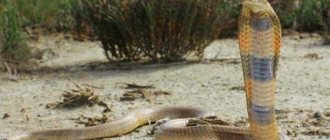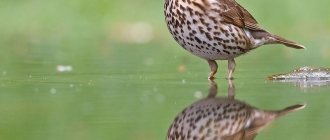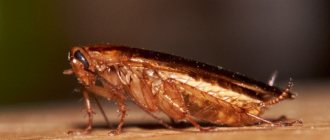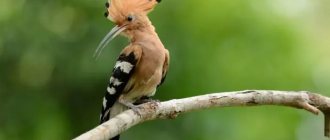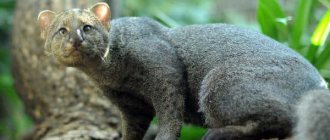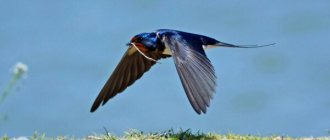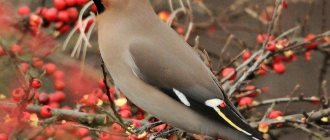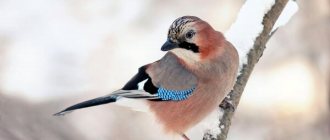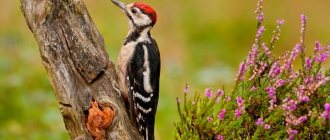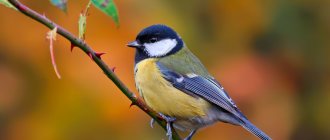- Wild animals
- >>
- Amphibians
The terrible leaf frog is one of the smallest frogs in the world. It is distinguished by its bright color and lives exclusively in tropical forests. The leaf frog has many distinctive features, which sets it apart from other frogs. Also, this creature received the title of “terrible” not by chance.
Origin of the species and description
Photo: Terrible leaf climber
The terrible leaf climber got its name for a reason - this little frog is one of the most poisonous creatures on the planet. Its poison is batrachotoxin, which quickly paralyzes the respiratory organs and heart. The frog belongs to the genus of leaf frogs, to the family of dart frogs. The genus of leaf climbers is known for its poisonous qualities. One individual of the leaf climber is capable of producing up to 500 micrograms of poison per day, which is a lot, considering the small size of the representatives of the genus.
Interesting fact: Most of the substances included in this poison are produced due to the diet of these frogs, so in captivity they partially lose their toxicity.
Frogs are covered with mucus, which can be absorbed into the skin and cause negative consequences. Upon contact with skin, the poison will cause death or may cause various complications with the respiratory system. If it gets into the mucous membrane, stomach or blood, the poison acts immediately. After contact with such a frog, you should at least wash your hands. All frogs of the genus have a bright, warning color.
Thanks to this coloring they:
- camouflaged in the tropical forest among green plants, flowers and fruits;
- warn large predators capable of killing the frog that it is poisonous, and its death will entail consequences in the form of the death of the predator.
The terrible leaf climber belongs to the poison dart frog family. Contrary to the name, they can live not only in trees, but also in fields, residential areas, pastures and plantations. Frogs of the family prefer a humid climate, although they do not live in water or near large water sources. Thanks to their bright colors, representatives of the poison dart frog family are not afraid of predators. They are active only during the day and sleep in their shelters at night.
Bicolor phyllomedusa
The bicolor phyllomedusa is a representative of one of the largest families of tailless amphibians, tree frogs. These are quite small frogs, the size of which usually does not exceed 119 mm. You can meet phyllomedusa in areas adjacent to the Amazon basin. Occasionally it appears in the Brazilian savannas and Cerrado forests.
The animal is green in color, the belly can be white or cream. On the limbs and chest of the phyllomedusa you can see several white spots that have dark edges. The frog's eyes are equipped with special glands that allow it to see freely while in water. It is a widespread species overall, but is still endangered.
Compared to some other frogs found in the Amazon, the bicolor phyllomedusa is relatively non-venomous. If its secretions get on the skin, the person will not die, although he will develop gastrointestinal disorders, and there is also a high risk of hallucinations. Phyllomidusa venom is used by Indian tribes in initiation rites for men and women, and it is also used to make some folk medicines.
Appearance and features
Photo: Terrible leaf climber frog
The terrible leaf climber is one of the smallest representatives of the family. Its maximum size reaches 4 cm. The color of the frog is acidic, bright: yellow, light green, light green, orange, bordering on red. Sometimes pale white individuals are found.
It is not difficult for predators to notice such a frog in an open area, but the leaf climber warns of its own poisonousness with its color. Sometimes frogs have black stripes on their front legs and head near the eyes. If the frog is already old, black round specks of varying sizes may appear on its body.
Video: Terrible leaf climber
The belly and inner part of the paws of the leaf climber are lighter than the body, and sometimes the shade reaches milky white. The eyes are large, black, located on the sides of the head and slightly bulging upward. Small nostrils at the end of the muzzle are clearly visible.
The toes of the terrible leaf climber are not webbed, which prevents the leaf climber from swimming. But at the end of each finger there is a round seal - suction cups, with the help of which the frog moves along vertical surfaces. The terrible leaf climbers have a total of four long fingers. Sometimes they are covered with black spots or have a darker shade than the entire body of the individual.
When producing sounds, leaf frogs, like many frogs, inflate their chest sac. On the skin of the terrible leaf climber you can clearly see pores that secrete poison - the entire frog is covered with poisonous mucus. This poison does not harm the frogs themselves, as well as other individuals of this family and genus.
Leaf climber - description, structure, photographs
Externally, the leaf climber looks like a frog. The amphibian has an elongated, dense body from 2 to 5.5 cm long, smoothly turning into a wide, flat head. The hind limbs are more developed than the front limbs, and one of the fingers is especially long.
Like all amphibians leading a terrestrial lifestyle, the leaf climber does not have membranes between the fingers, but the tips of the fingers are expanded into peculiar suckers, covered with dentate epithelium and ducts of numerous mucous glands that secrete an adhesive secretion. This structure of the limbs allows animals to easily move along the branches and leaves of trees.
Photo credit: Jiel Beaumadier, CC BY-SA 4.0
The leaf climber's eyes are large and bright, and the iris is dark brown or black.
Photo credit: Wilfried Berns, CC BY-SA 2.0
The skin of most leaf climbers is smooth and very thin, with a bright warning color of a wide variety of color combinations, which signals to predators that there is a poisonous object in front of them. Therefore, leaf climbers have practically no natural enemies: an animal that survives an attempt to feast on brightly colored prey will avoid these amphibians for the rest of its life.
Where does the terrible leaf climber live?
Photo: Terrible leaf climber in the tropics
These are tropical frogs that live mainly in the south and west of Colombia. They prefer dense tropical forests with lots of vegetation. They live in the lower tiers of the tropics - in grass, flowers, in the roots of trees and plants.
These amphibians can often be seen in the following areas:
- South and Central America;
- Panama;
- Costa Rica;
- Nicaragua.
The terrible leaf climber does not create permanent shelters for itself - at night it looks for a new home. They usually spend the night under dense leaves, roots, and wet stones, burrowing into damp soil. They can also be seen hiding in damp grass and in cracks in trees, rocks and earth.
Unlike many other species of frogs, leaf frogs are not waterfowl, although they need moisture. They do not settle near running water; they avoid streams and, especially, rivers. This can be justified by their size, since any stream of water can drown such a small individual. But leaf climbers need moisture, so they like to sit where there is a greenhouse effect, and also bathe in large drops of dew or rain puddles.
Frogs hide from tropical downpours on the upper tiers of trees, hiding behind wide leaves or in cracks in the tree bark.
Interesting fact: Local tribes use frog poison to poison arrows.
Dire leaf crawlers are territorial creatures that jealously guard their borders against members of their own sex. Now you know where the terrible leaf-climbing frog lives. Let's see what the poisonous amphibian eats.
Blue dart frog
Opinions vary as to what the blue dart frog is. Some distinguish it as a separate species of dart frog, while others consider it a subspecies of the previous representative of the most poisonous frogs in the world, the spotted dart frog. This animal is of average size - no more than five centimeters. As the name suggests, the body is painted blue, while the paws are blue. There are many black spots on the surface of the skin.
Most often you can find the blue dart frog in the largest district of Suriname, Sipaliwini. These frogs prefer the ground and foliage of savannah rainforests. Here they find insects for food. Blue dart frogs are being actively hunted by local hunters and are therefore endangered.
This species differs from most poison dart frogs by uniting in large groups. Usually about fifty individuals live together. They live on coastal rocks, which are covered with bushes. Females use a nearby body of water to lay eggs and raise tadpoles.
Blue dart frogs use their venom for more than just repelling predators. With its help, the animal fights pathogenic microorganisms such as bacteria and fungi. Like most spotted poison dart frogs, the blue is also a popular terrarium animal.
What does the terrible leaf crawler eat?
Photo: Poisonous terrible leaf climber
Dire leaf crawlers are very voracious creatures, which is why their metabolism is very fast. Therefore, three days of hunger, which is normally perceived by other frogs, can kill a leaf climber. They constantly need feeding; they must have digestible food in their stomach.
The daily diet of the terrible leaf climbers includes:
- ants, including poisonous ones;
- small beetles;
- mites;
- grasshoppers;
- flies;
- small spiders;
- moths;
- springtails;
- woodlice.
The tongue of leaf climbers is not that long - it is approximately the length of the frog's body. They are sensitive to the slightest movement and are very patient hunters. Hiding in a secluded place, the leaf climber notices the victim and allows it to come as close as possible. It then shoots out its long, sticky tongue, catching its prey and immediately eating it. Leaf climber tadpoles feed on plant foods and organic debris. They are also capable of eating the eggs of other amphibians. The terrible leaf climber is often kept as a pet. In this case, the frogs are fed twice a day: in the morning and in the evening, and there must be living creatures in the terrarium so that the frog can have a snack at any time.
The diet of domestic leaf climbers usually includes:
- springtails (small arthropods, often used as food);
- bloodworms;
- spiders;
- woodlice;
- tubifex;
- fruit flies.
This diet reduces the toxicity of frogs, making them less dangerous to keep in captivity.
Keeping leafhopper at home
Due to their bright colors, diurnal lifestyle and extraordinary activity, leaf climbers are often kept as exotic pets. Basic maintenance conditions: suitable temperature, lighting, air humidity, appropriate soil and proper diet.
Terrarium
To keep 2-3 pairs of amphibians at home, you will need a spacious terrarium with a volume of at least 60x60x60 cm. In order not to damage the delicate skin of animals, gravel or sand should not be used as soil. The best option would be a mixture of rotted leaf soil, coniferous soil and sphagnum moss in a ratio of 2:1:2. A small area of the litter can be covered with moss or lichen and be sure to plant ground and epiphytic plants. Among the epiphytic ones, it is worth giving preference to the bromeliads, which are close to animals, with smooth leaves that will accumulate moisture and serve as a drinking bowl, bathtub and incubator for animals.
Temperature, lighting, humidity
The temperature in the amphibians' home is maintained at +27 degrees during the day and at least +23 at night. The main source of heat will be special terrarium heaters buried in the ground, and during the day the animals must be provided with lighting from incandescent lamps with a power of no more than 40 W, and ultraviolet lamps for amphibians. Humidity is maintained at 85-95% through regular spraying.
What to feed the leaf climber
For normal life activity, leaf climbers need frequent and plentiful feeding, so amphibians will have to be fed daily, morning and evening. Leaf climbers happily eat crickets, springtails, fruit flies, flies, spiders, bloodworms, woodlice, and tubifex flies. In addition to regular feeding, food should always be present in the leaf climber’s home.
Features of character and lifestyle
Photo: Terrible leaf climber from the Red Book
In general, the dire leaf climber is not that terrible - they do not attack first and are only poisonous to those who deliberately attack them. Females and males have no external sexual differences, but they are different in behavior. Males are warlike against each other. Each male leaf climber has his own site, where from three to ten females live. The male mates with these females and protects them from the attacks of other males.
If another male appears nearby, then the owner of the site begins to demonstrate his skills: he screams piercingly, and his cry is similar to the trill of a bird. Two males can sit opposite each other for hours and scream warlikely. Rarely does it come to a fight - males can bite each other and also hit each other with their paws - this is reminiscent of freestyle wrestling. If the arriving male wins, he drives away the owner of the territory and takes the area for himself along with a harem of females.
Sometimes females can be aggressive towards each other - the reason for this behavior has not yet been identified. They may also yell at each other or even fight, but are usually peaceful. Females calmly move around the male’s territory and can move to other areas in other harems without consequences. Despite their territorial lifestyle, individuals of the terrible leaf climber live quite separately. They do not have common shelters, do not hunt together and do not have any kind of hierarchy.
Each individual spends the entire day hunting - they wait for insects in ambush. At night, they go to shelters - this can be justified by the fact that at night predators may not distinguish the bright warning color of the frog and eat it, which will be disastrous for both. At home, the terrible leaf climber can also be housed in groups of several females or a male with females. They feel great in a terrarium and reproduce readily.
The benefits and harms of poison dart frogs
Tree frogs are needed by nature and are very useful. They destroy a large number of insects, thus reducing the number of crop pests. Despite the fact that they secrete a toxic mixture, frogs do not harm the environment.
But a person should avoid some types of poison dart frogs, because they can be poisonous.
The dart frog's venom can kill a person in half an hour.
When kept at home, the frog loses toxicity and becomes safe. This is possible with proper feeding and specially created conditions.
Dart frog toxin is popular in medicine. It is not yet used in medicines, but scientists are actively looking for uses for it. An antibiotic has already been developed, which is based on a frog toxin that can save you from serious diseases, and a product has been released that allows you to fight insects.
The mucus of the dye dart frog has an analgesic effect comparable to that of morphine. Scientists also plan to use it in the future.
Social structure and reproduction
Photo: Terrible leaf climber
Dire leaf climbers have an unusual system of sexual maturation - it depends on the size of the frog, and not on its age. To begin producing offspring, a male needs to reach a length of at least 3.7 cm, and a female - 4 cm. These amphibians have a mating season, which falls during the rainy season - it is at this time that the frogs gather in large groups under the leaves and bark trees to hide from the drops.
Interesting fact: The terrible leaf climber is born non-poisonous, and only with age through food it acquires components that allow it to produce poison.
The male fertilizes all the females of the harem during a given period. Fertilization occurs during the laying of eggs, which remain in moist dry land under stones or leaves. Most often, females choose bromeliad leaves for laying. There are not many eggs - only about 15-30 eggs, so almost all frog individuals survive.
The female leaves the clutch immediately after fertilization, leaving it to the male. The male monitors several clutches at once, burying the eggs in moist soil and protecting them from possible attacks. Sometimes he even stirs the caviar so that the moisture is evenly distributed.
After the tadpoles appear, the male collects them on his back - they stick to him with the help of mucus and live in it for some time, feeding on substances secreted by the male’s skin. Future frogs also feed on the remains of the egg yolk. They are not in any danger on their father's back, so they stay on it for about a week.
Tadpoles can live in water, but there they tend to attack each other and eat their relatives. After two weeks they become full-fledged frogs. It is not known for certain how long the terrible leaf climbers live in the wild, but in captivity and with proper care they live up to 10 years.
Common types
There are 30 species of dart frogs in nature. Each one is unique in its own way.
Darter frog blue
The blue poison dart frog has impressive dimensions for this species (up to 5 cm). Endowed with bright, eye-catching colors. More often it is a blue tint in various variations, framed by black dots and spots. They are randomly located on the animal's body.
The blue dart frog grows up to 5 cm - this is a large size for this species
This tree frog is unusually photogenic.
Spotted poison dart frog
This frog is called a tree frog; its dyers reach a length of 7 cm. Its sides have a bright yellow tint, but its limbs are black or dark blue.
The spotted poison dart frog changes color depending on environmental conditions and nutrition.
The color of a frog can change depending on environmental conditions, soil, air and nutrition. More often found in Suriname, it leads a terrestrial lifestyle with virtually no immersion in water. Lives mainly in trees.
Natural enemies of the terrible leaf climber
Photo: Terrible leaf climber frog
The terrible leaf climber has almost no natural enemies. Thanks to its color, predators prefer to avoid this amphibian, because they instinctively understand that bright color is a sign of danger. Therefore, the leaf climber lives, deliberately attracting the attention of predators and not hiding in secluded places.
But sometimes the following predators can feast on the terrible leaf climber:
- poisonous snakes and lizards, especially nocturnal ones. They are colorblind, so they can attack the terrible leaf climber without understanding its warning coloration;
- large spiders. Due to their small size, leaf climbers can get caught in a web from which they cannot get out. Poisonous spiders are also vulnerable to frog venom, so both spiders may die;
- small birds, in particular nocturnal ones.
Most often, tadpoles are attacked - in streams and reservoirs they are eaten by fish, small birds, lizards, spiders and snakes. Tadpoles are not poisonous, so they are a tasty morsel for many representatives of tropical fauna.
The terrible leaf climber does not lead a secretive lifestyle - thanks to its bright color it can be seen from afar, especially when the amphibian sits on the dark bark of a tree. If a leaf climber is attacked by some kind of predator or bird, it begins to scream shrilly. They never run or hide; on the contrary, the terrible leaf climber quickly moves towards the attacker and screams. As a rule, this behavior bears fruit - the predator hastily leaves, because contact with a leaf climber that persistently moves towards the enemy is fatal.
Population and species status
Photo: Poisonous terrible leaf climber
Leaf climbers are close to vulnerable. There are several reasons for this. For example, deforestation. Rainforest areas are being actively developed by people, and this is destroying the natural habitat of the terrible leaf climbers. Along with the forests, the species that the leaf climber feeds on are destroyed. Even a three-day fast is disastrous for this amphibian, but they are increasingly left without sufficient food.
Also, climate change - lack of rain, sudden cold snaps and warming temperatures have a bad effect on the terrible leaf climbers, which are accustomed to certain stable temperatures. Of course, environmental pollution - leaf climbers react sensitively to production waste.
Breeding of hostile species such as spiders, snakes and lizards. Due to the lack of other food, they increasingly attack individuals of the terrible leaf climbers, which leads to disruption of the population on both sides. There is a refusal to reproduce. Due to lack of food and unstable living conditions, leaf climbers ignore the rainy season and mating season, due to which the population also suffers.
Catching leaf climbers as pets. This is not so harmful to the population, since in a terrarium the terrible leaf frogs live long and reproduce, but catching wild adult frogs often leads to their aggression towards humans and, accordingly, such frogs are not suitable for home life.
Interesting facts about leaf climber
- For a long time, the natives of Colombia used the poison of the leaf climber, running arrow tips along the back of the amphibian and thus obtaining a powerful deadly weapon.
- Recently, scientists discovered a poison similar to batrachotoxin in thrush flycatchers living in New Guinea. Scientists suggest that these birds receive the poison from the same beetles as the leaf climbers, and have also developed immunity to its effects.
- Deforestation and drainage of the natural habitats of leaf climbers have led to a sharp decline in the population, and today these extraordinary amphibians are considered an endangered species.
Photo by: Micha, CC BY-SA 3.0
Did you like the article? Share with your friends:
